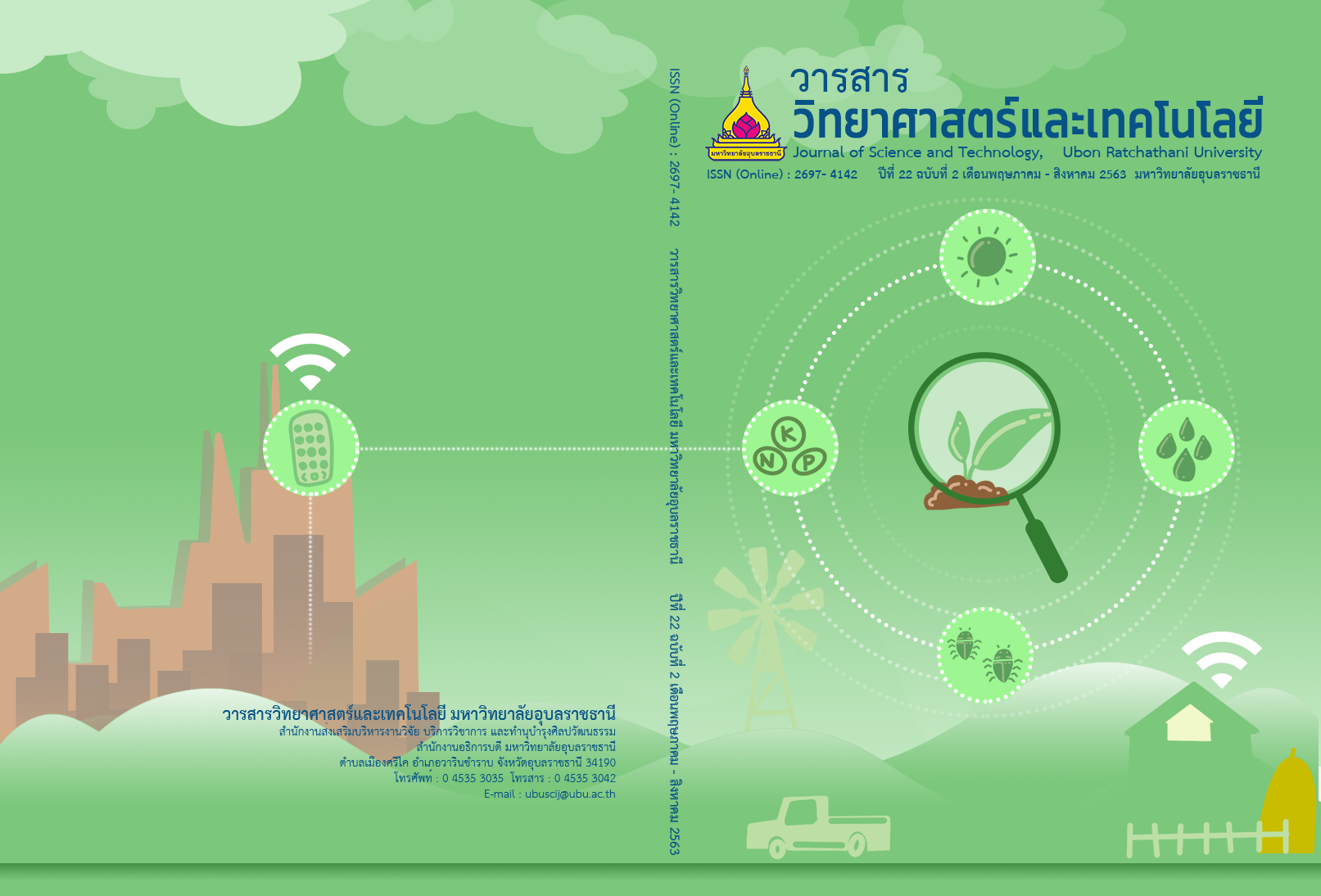การใช้ประโยชน์จากเปลือกฟักข้าวเป็นแหล่งใยอาหารในสปองจ์เค้ก
Main Article Content
บทคัดย่อ
ปัจจุบันมีการแปรรูปเยื่อหุ้มเมล็ดของฟักข้าวเพื่อใช้ในอุตสาหกรรมยา และเครื่องสำอางอย่างแพร่หลาย ก่อให้เกิดวัสดุเหลือทิ้งได้แก่ น้ำ เนื้อ และเปลือก สูงถึงร้อยละ 90 โดยผลพลอยได้เหล่านี้อุดมไปด้วยสารต้านอนุมูลอิสระ (antioxidant compound) และเป็นแหล่งที่ดีของใยอาหาร ที่เหมาะแก่การนำมาผลิตเป็นผงใยอาหาร งานวิจัยนี้ได้ทำการผลิต และศึกษาคุณสมบัติต่าง ๆ ของผงใยอาหารจากเปลือกชั้นในของผลฟักข้าวสุก พบว่าผงใยอาหารจากเปลือกฟักข้าวสุกที่สกัดได้มีปริมาณความชื้น โปรตีน ไขมัน เถ้า กากใย และคาร์โบไฮเดรต เท่ากับร้อยละ 5.10, 1.42, 0.02, 6.16, 34.43 และ 52.87 ตามลำดับ ตัวผงมีสีเหลืองขุ่น และมีความสามารถในการอุ้มน้ำเท่ากับ 4.45 กรัมน้ำ/กรัมตัวอย่าง และน้ำมันเท่ากับ 2.26 กรัมน้ำมัน/กรัมตัวอย่าง นอกจากนี้ยังศึกษาการระดับผงใยอาหาร และเยื่อหุ้มฟักข้าวที่เหมาะสมในการทดแทนปริมาณแป้งสาลี และน้ำในผลิตภัณฑ์สปองจ์เค้ก พบว่าสปองจ์เค้กสูตรทดแทนแป้งสาลีด้วยผงใยอาหารจากเปลือกฟักข้าวร้อยละ 10 และทดแทนน้ำด้วยเยื่อหุ้มฟักข้าวร้อยละ 25 มีคะแนนความชอบสูงที่สุดในทุกคุณลักษณะจากการทดสอบชิมที่ระดับความชอบปานกลาง และมีองค์ประกอบทางเคมี ได้แก่ ความชื้น โปรตีน ไขมัน คาร์โบไฮเดรต ใยอาหาร และเถ้า เท่ากับร้อยละ 33.54, 10.60, 0.24, 40.62, 12.93 และ 0.07 ตามลำดับ
Article Details
บทความที่ได้รับการตีพิมพ์เป็นลิขสิทธิ์ของ วารสารวิทยาศาสตร์และเทคโนโลยี มหาวิทยาลัยอุบลราชธานี
ข้อความที่ปรากฏในบทความแต่ละเรื่องในวารสารวิชาการเล่มนี้เป็นความคิดเห็นส่วนตัวของผู้เขียนแต่ละท่านไม่เกี่ยวข้องกับมหาวิทยาลัยอุบลราชธานี และคณาจารย์ท่านอื่นๆในมหาวิทยาลัยฯ แต่อย่างใด ความรับผิดชอบองค์ประกอบทั้งหมดของบทความแต่ละเรื่องเป็นของผู้เขียนแต่ละท่าน หากมีความผิดพลาดใดๆ ผู้เขียนแต่ละท่านจะรับผิดชอบบทความของตนเองแต่ผู้เดียว
เอกสารอ้างอิง
[2] Sosulski, F.W. and Cadden, A.M. 1982. Composition and physiological properties of several sources of dietary fiber. Journal of Food Science. 47: 1472 – 1477.
[3] Rodriguez, R.; Jimenez, A.; Fernandez-Bolanos, J. et al. 2006. Dietary fiber from vegetable products as source of functional ingredients. Trends in Food Science and Technology. 17: 3 – 15.
[4] Supamityotin, P. 2013. Food and nutrition. Bangkok: Odeon Store Publisher. (in Thai)
[5] Thumwaro, V. 2014. Production and Application of Fiber from agricultural raw material residues. Food. 44(3): 18 - 23. (in Thai)
[6] Prakongpan, T., Nittithamyong, A. and Luangpituksa, P. 2002. Extraction and application of dietary fiber and cellulose from pineapple core. Food chemistry and toxicology. 67(4): 1308 - 1313.
[7] Anusananan, N. (2010). Gac fruit: high lycopin: anticancer. Natural Agriculture. 13(12): 4-5. (in Thai)
[8] Lelamanit, V. (2014). Gac fruit. Department of Biochemistry, Faculty of Medical, Mahidol University (in Thai)
[9] Ishida, B. K., Turner, C., and Chapman, M. H., et. al. 2004. Fatty acid and carotenoid composition of Gac (Momordica cochinchinensis Spreng) fruit. Journal of Agricultural and Food Chemistry. 52(2): 274 - 279.
[10] Norrish, A. E., Jackson, R. T., and Sharpe, S. J., et. al. 2000. Prostate cancer and dietary carotenoids. American Journal Epidemiol. 151(2): 119 - 123.
[11] Sangnark, A. 2003. A. Effect of particle sizes on functional properties of dietary fiber prepared from sugarcane bagasse. Food Chemistry. 80: 221 – 229.
[12] Association of Official Analytical Chemists (AOAC). 2005. Official methods of analysis of AOAC International, (18th edition). Gaithersburg: AOAC international.
[13] Ang, J. F. 1991. Water retention capacity and viscosity effect of powered cellulose. Journal of Food Science. 56 (2): 1682 - 1684.
[14] Chaiya, B. and Pongsawatmanit, R. 2011. Quality of batter and sponge cake prepared from wheat-tapica flour blends. Kasetsart Journal (Natural Science): 45, 305 - 313. (in Thai)
[15] Wanlapa, S., Wachirasiri, K., and Sithisam-ang, D., et. al. 2015. Potential of selected tropical fruit peels as dietary fiber in functional foods. International Journal of Food Properties. 18: 1306 – 1316.
[16]. Chaiya, B. and Pongsawatmanit, R. 2011. Quality of batter and sponge cake prepared from wheat-tapica flour blends. Kasetsart Journal (Natural Science) 45: 305 - 313. (in Thai)
[17] Go’mez, M, Ronda, F, and Caballero, et. al. 2007. Functionality of different hydrocolloids on the quality and shelf-life of yellow layer cakes. Food Hydrocolloids. 21: 167 - 173.
[18] Kaewnate, S. 2019. Quality Characteristics of Shiffon Cakes with Addition of Gac Fruit (Momordica cochinchinensis Spreng). Journal of Vocational Institute of Agriculture. 3(1): 18-27. (in Thai)
[19] Aoki, H., Kieu, N.T.M., and Kuze, N., et. al. 2002. Carotenoid pigments in GAC fruit (Momordica cochinchinnensis Spreng). Bioscience Biotechnology & Biochemistry. 66: 2479 - 2482.
[20] Taghipoor M, Barles G, Georgelin C, et al. 2014. Digestion modeling in the small intestine: Impact of dietary fiber. Mathematical Biosciences: 258: 101 – 112.
[21] Vuong, L.T., Franke, A.A., and Custer, L.J. et. al. 2006. Momordica cochinchinensis spreng (Gac) fruit caroteniods reevaluated. Journal of Food Composition and Analysis. 19: 664 – 668.


